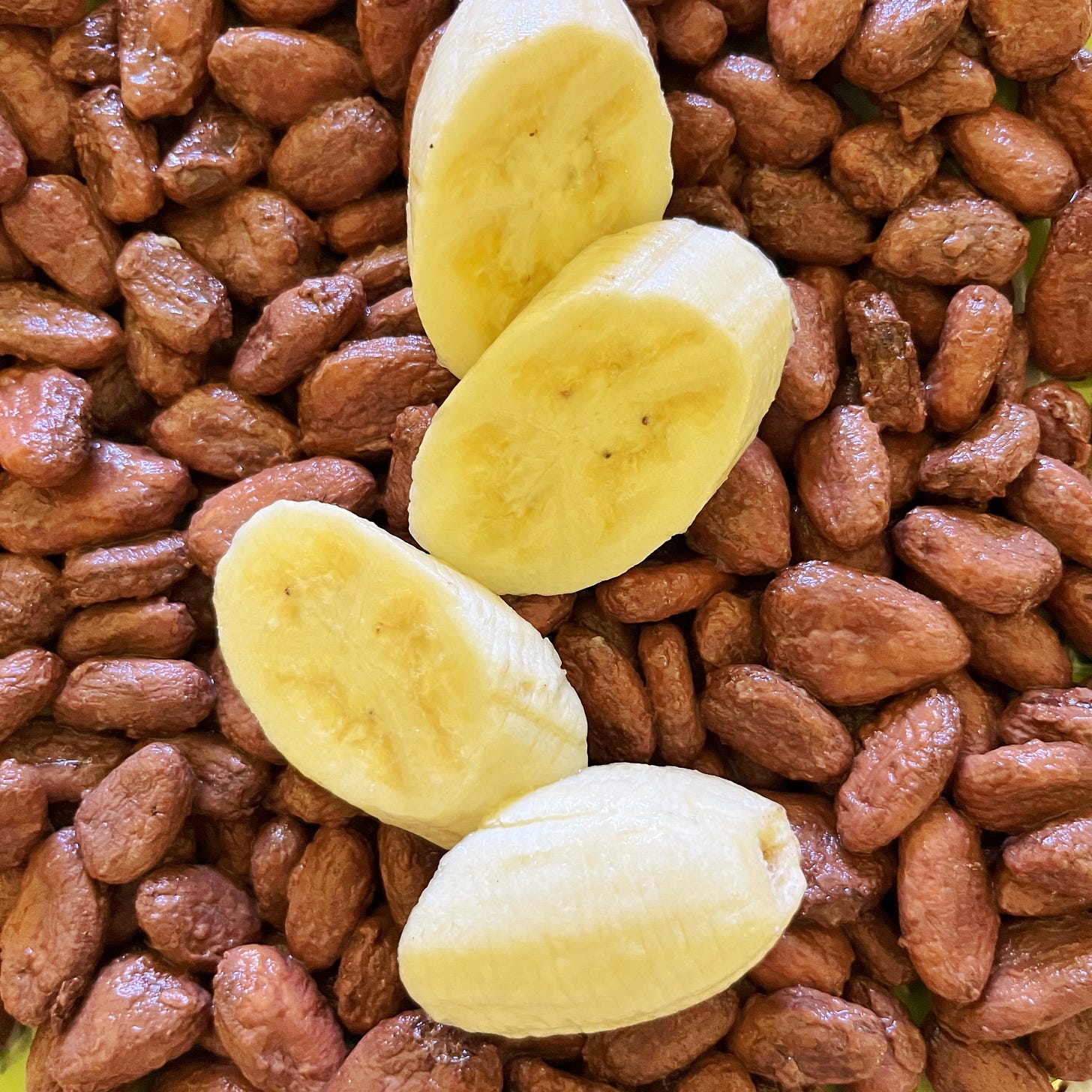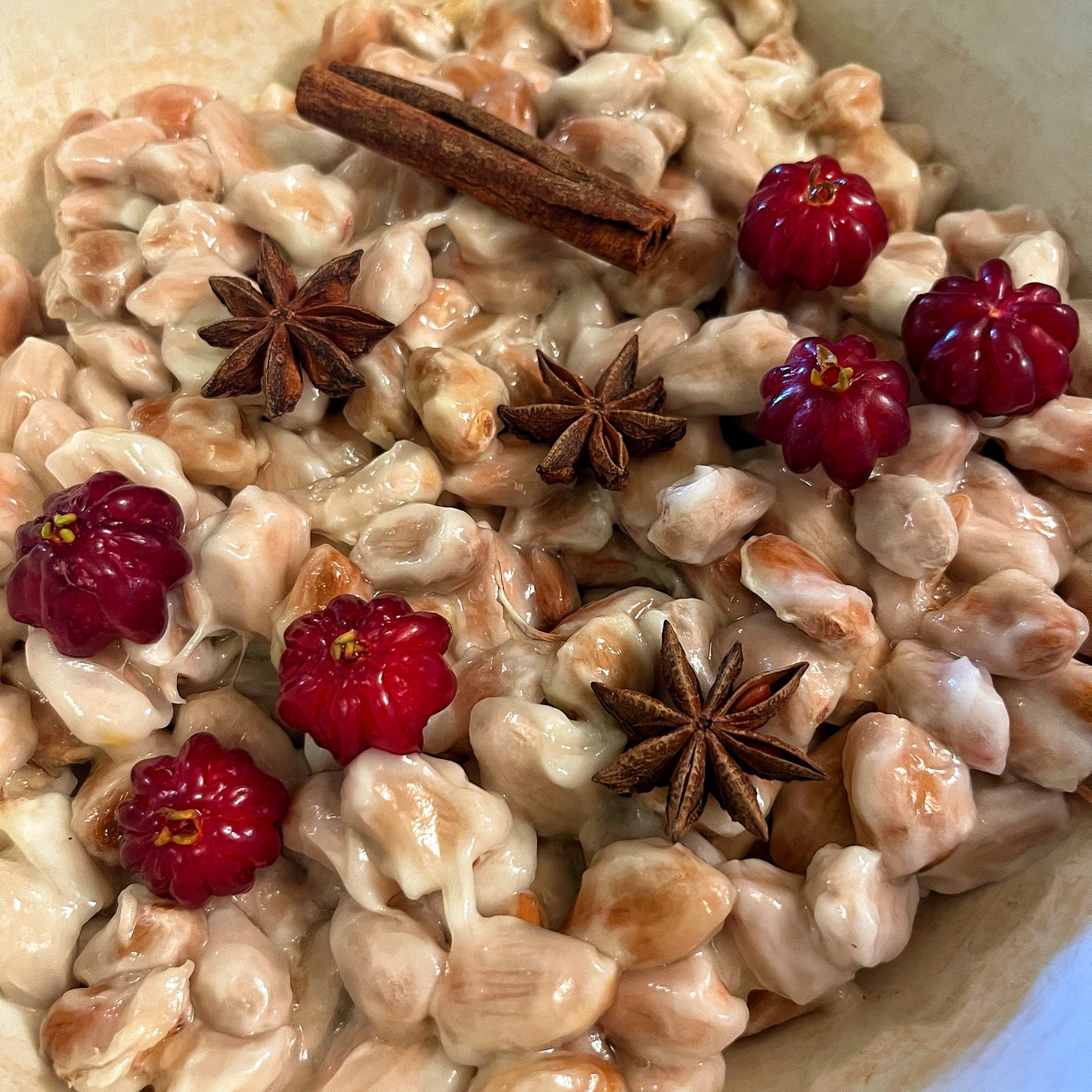Double Fermentation
Change flavor through re-fermenting cocoa beans, the cacao fermentation everyone can do
Have you heard of double fermentation, and did you know it is not a fringe practice? While I imagine anyone who has fermented cacao at some point thinks, hmmm… how would the cocoa bean flavor be affected if I threw this fruit or spice in, but I did not know this was something big makers like Valhrona did. I decided to dig in deeper, and here’s what I found out. For all you creative, fermentation-loving folks out there, double fermentation is a playground of possibilities both for people working with wet beans and dried beans.

Double fermentation in the mainstream is newish, but well-known chocolate producers are embracing it. The term seems to refer to two distinct techniques, one involves cocoa beans before drying and the other after drying.
Double fermentation style 1 (before drying)
This post is prompted by a Pod Save Chocolate YouTube video. Yet again, Clay Gordon’s discourse fueled by an encyclopedic knowledge of chocolate has prompted me to the Google search bar. Discussing a double fermented chocolate bar by Fu Wan Chocolate, he described the process as adding new ingredients into a cacao fermentation at the first turn, which is usually a couple of days into the ferment. A similar process is also described by Whitaker’s Chocolate. At this point in the fermentation, the yeasts are well on their way to gobbling up all the sugar in the pulp, so adding fruit to the ferment, like banana or grapes, gives the yeast more fuel at the point when their numbers would start waning. This would allow more alcohol production and thus more acid production, as well as a longer time that the seeds sit in a acidic juices.
Valhrona describes their double fermentation process as adding fruit (passion fruit) after fermentation is complete but before drying, so at a later time point than those mentioned above. I imagine this would kick-start the yeast again, but I wonder what happens with the temperature at this point. The high temperature of late fermentation would not be great for yeasts. So, perhaps the newly introduced sugars are feeding bacteria (LAB).
The point of adding fruit is to add interesting fruity flavors to the finished chocolate. Some of the aromatics from the fruit will cross the seed coat and potentially end up in the finished chocolate. I suspect that some perception of fruitiness will also come from additional acids resulting from the infusion of additional sugar.
You should be able to jump-start a double fermentation by adding anything with sugar. Try fruits, honey, maple syrup, coconut sap, or anything else sugary.
Dandelion Chocolate made delicious bars that included spices in the fermentation. While this is not a double fermentation (no sugars to cause a yeast explosion), just an almost-inclusion chocolate, I mention that here because the acquisition of flavor from fruits in a double fermentation may be similar to those on these spice chocolates. Dandelion’s finished chocolate did take on flavor from the spice but in a different way than if spice was added to the finished chocolate. It tasted more like a partial representation of the flavor spectrum of the spice, likely including the flavor molecules that were not broken down, able to cross the seed shell, and did not waft away during processing. The fruity flavor of a finished double fermented chocolate is likely to be similar, meaning the result not exactly predictable by the input. I look forward to trying!
Here on the Hawai‘i Island, I’ve heard many people say they add fruit or sugar at the start of fermentation. The intention is to make sure the microbes have plenty of fuel for the ferment. This would not be considered a double fermentation, but it may add some flavor notes from the fruit. Who can report in about that?

Double fermentation style 2 (after drying)
Now, this is a technique I’m reluctant to admit I never even considered. My friends in non-tropical region, pay attention: this is super cool! People are taking fermented, dried beans, shipped across oceans and landed in temperate areas, and re-fermenting them.
EatCultured and Raaka collaborated on a cultured chocolate bar. They describe the process as: “We did a controlled natural fermentation step on carefully chosen organic cacao beans from the Dominican Republic just prior to making the bar. This extra fermentation step reduces the amount of sugars and brings up more pronounced chocolaty notes, delicate spices and ripe mango flavors.”
EatCultured’s main gig is “cultured coffee,” which is fermented green (dried, unroasted) coffee beans. They are choosing microbes to add that may give desirable changes to the coffee, like less caffeine, less bitterness, and better digestibility. I assume they used the same selected microbes for the chocolate, but I’m don’t know.
In researching this topic, I came across this patent from researchers in India (2020). They describe a second fermentation of dried beans using either banana or grape. Their intention was to increase health properties (like antioxidant activity). They mention that drying the beans in between the ferments allows more chocolate flavor to develop than putting the fruit into the first ferment.
The patent’s description of the second fermentation is as you would expect: soaking the dried beans in water and adding fruit. While you could select microbial stains (your favorite wine yeast and vinegar mother, for example), the outside of the dried cocoa beans should still have plenty of microbes in suspension just waiting to enjoy the buffet of a second fermentation. The added fruit will also introduce microbes. Interestingly, they did not report turning the second fermentation. Since turning encourages bacteria and acid formation, perhaps they wanted to keep the acidity of the beans in check. Perhaps this second fermentation is not about the fermentation itself, but is simply providing time for molecules from the fruit to diffuse into the beans.
If the point of the second fermentation on dry beans is to simply infuse molecules of flavor or health, this is not too different than what people do regularly: infusing nibs in alcohol (or mead or kombucha), then dehydrating. Of course, this is usually done with roasted and winnowed nibs. As with all things cacao, the spectrum of possibilities does not fit into neat boxes.
More into fungus than bacteria? The fabulous J Street Chocolate, who has been playing with koji-ferments with cocoa nibs for many years, making cocoa miso and shoyu. I’m fortunate to have had instruction from Julia Street through a chocolate experimentation group run by (creative genius) Mackenzie Rivers. To ferment cacao with koji, you can follow general protocols, replacing a portion of the soy or other beans with cocoa nibs or beans. J Street now includes Shared Cultures’ cocoa nib miso (a collaboration with Dandelion Chocolate) in the delicious miso bars. I just learned about this product—Yes, I plan to order a jar!
For further reading on this topic, check out this Chocolate Professor post called The Wild New World of Flavor Fermentation in Cacao. One interesting point mentioned: when do we categorize a flavor ingredient as an inclusion and when is it not? The Luke Owen Smith writes, “Co-fermented chocolate is a somewhat controversial issue in the world of chocolate awards, because it blurs the border between ‘plain’ dark chocolate and flavored bars. The flavor is infused during fermentation, but it doesn’t need to be a listed ingredient on the chocolate wrapper.” Yet again cacao chuckles at human attempts to define categories!

Double fermentation and you
I may have excitedly told all of this to someone close to me, and I may have received a “meh” response with the comment “sounds like a lot of work.” Is double fermentation cool enough to be worth it? It depends on your intention. Certainly there are easier, more direct, and more consistent ways to add banana flavor to your chocolate. But if you enjoy letting go of control and collaborating with microbes and molecules, this may be the next new thing for you. You may be interested to try a double fermentation technique if you:
love fruity chocolate
want to play with fruit flavors
play enthusiastically with microbes, but maybe don’t have access to cacao pods
play enthusiastically with microbes and want to try a new game
desire to give non-awesome-tasting cocoa beans another chance
are obsessed with trying everything
Are you as inspired by these techniques as I am? Have you already been playing with them? Let us know in the comments. I’ll report back with the results of my experiments, too.
News
Join me at the HCCA conference on O‘ahu, July 11-13. I’ll be speaking about drinking chocolate, joining an international lineup of speakers. You’ll learn practical information about growing and processing cacao and packaging chocolate. You’ll be inspired by talks on health benefits as well as ceremonial and unfermented cacao. Most importantly, you will connect with other people who love working with cacao. Will you be there? Let me know. I look forward to strengthening our community!



This is so exciting Raven. I'd never considered, or heard of, a 2nd ferment. Your mention of the cacao miso group brought back fond memories! My trials attempting the cacao nib miso were...weird...due, I think, to temperature fluctuations. With my profusion of blackberries and plums here, I am looking forward to trying this. Thank you, as always, for this cool post.
What an informative article.
I talked with the chocolatier that a friend brought by who was interested in fruit infused for cow beans with what we had growing on our farm. That was several years ago and I didn’t have a clue what I was doing, but I did have about four different batches going with banana, mango, jackfruit, and pineapple.
I didn’t know how long to leave the fruit in, when to add it or any of the scientific information behind what I was doing. My experiment didn’t turn out great, and I only made small batches that I didn’t put to the final test and actually make chocolate out.
After reading your article, though, I’m very interested in doing just that.
I’ll let you know how it turns out.
I’m out of state for the summer, and won’t be able to attend the conference , but would love to know what you learned at the conference in July.
I hope that you will share the information with the rest of us.
I really look forward to reading your articles Raven, and appreciate all your guidance in this journey. Mahalo.